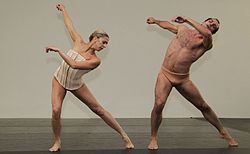Semperoper ballet
| Semperoper ballet | |
|---|---|

|
|
| Founder: | Carl Maria von Weber (1825) |
| Hometown: | Dresden |
| Members: | 80 |
| Technology: | classical ballet and modern dance |
The Semperoper Ballet forms the ballet division in the Semperoper in Dresden .
history
At the electoral court in Dresden there were first ballet performances as early as the 17th century as part of weddings, birthdays, baptisms and other celebrations. For example, August Buchner's ballet opera Orpheo and Eurydice was premiered on November 20, 1638 under the direction of Hofkapellmeister Heinrich Schütz in Dresden Palace .
After the opening of the opera and comedy house built by Wolf Caspar von Klengel on the Taschenberg in 1667, ballet performances were regularly held there, but it was not until 1825 that Carl Maria von Weber secured the permanent position of a ballet ensemble at the Dresden court theater . By performing works by u. a. Léo Delibes and Josef Bayer succeeded in consolidating the independent position of ballet at the end of the 19th century. In the 1920s, ballet experienced its first heyday under the direction of ballet master Ellen Cleve-Petz.
After the building was destroyed in February 1945, the ensemble had to temporarily move to other venues. Josef Bayer's Puppenfee was the first ballet premiere that took place in Dresden after the Second World War on December 7, 1946 . In the 1950s and 60s it was mainly Tom Schilling who promoted the Dresden Ballet.
In 1985 she returned to the rebuilt Semperoper with the world premiere of Harald Wandtke's Burning Peace to the music of Udo Zimmermann. Wandtke directed the ballet from 1978 to 1993. Choreographies by Oleg Winogradow, Konstantin Russu, Hilda Riveros, Emöke Pöstenyi and Birgit Cullberg were part of the repertoire during this time. In 1993 Vladimir Derevianko took over the direction of the Dresden Ballet and expanded the repertoire to include works by Mauro Bigonzetti , Mats Ek , Jiří Kylián , John Neumeier , Uwe Scholz and Stephan Thoss .
On August 1, 2006, the Canadian Aaron S. Watkin succeeded Derevianko as ballet director.
The Semperoper Ballet was awarded the European Culture Prize Taurus in 2018 .
ensemble
The first soloists in the 2017/2018 season are Svetlana Gileva, Sangeun Lee, Anna Merkulova, Courtney Richardson, Jón Vallejo, Denis Veginy and Dmitry Semionov, who have been a permanent guest since 2007. The ensemble also includes 4 first character soloists, 4 soloists and 10 semi-soloists. The company is international with around 60 dancers from 24 nations. Since 2006 she has been running an Eleven program together with the Palucca School , whereby six students from the university can personally support the performances and thus gain stage experience.
repertoire
In addition to the classical ballet repertoire (including Swan Lake , Giselle , La Bayadère , Sleeping Beauty), the Semperoper Ballet also has a repertoire of pieces that are rarely or only played here. The Semperoper Ballet presents over 90 performances every season on the stages of the Semperoper and internationally on tour.
Since 2011 the Semperoper Ballet has also played on the new stage of the Semperoper “Semper Zwei”.
Guest performances
In the years after its reorganization, the company has made guest appearances under ballet director Aaron S. Watkin to New York, Barcelona, Abu Dhabi, St. Petersburg, Antwerp, Paris, St. Pölten, Gothenburg and South Africa.
In the 2017/18 season the Semperoper Ballet will tour The Joyce Theater in New York City with Stijn Celis ' "Vertigo Maze", David Dawson's "On the Nature of Daylight" and a world premiere by Joseph Hernandez: "The night comes very quietly" . There is also a tour to the National Arts Center in Ottawa, Canada with Aaron S. Watkins "Swan Lake". The trip also led to the Dance Salad Festival in Houston, Texas - for the 5th time. In June 2018 the company presented itself with "All Forsythe" at Sadler's Wells Theater in London.
literature
- Peter Jarchow: Advanced Music in the State Opera Ballet (1966-1999) , in: Dresden and advanced music in the 20th century. Part III: 1966-1999 , ed. by Matthias Herrmann and Stefan Weiss, Laaber 2004, pp. 191–199 ( Musik in Dresden 6), ISBN 3-89007-511-8
Web links
Individual evidence
- ↑ Olga Artsibacheva: The Reception of the Orpheus Myth in German Musical Dramas of the 17th Century , p. 51
- ↑ http://europaeischer-kulturpreis.de/preistraeger/


